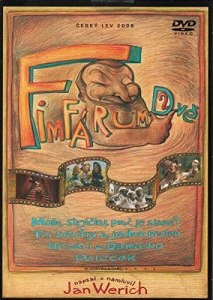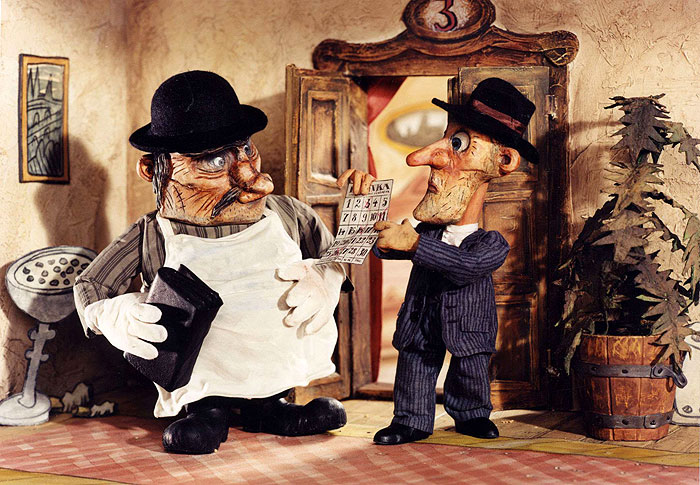

Fimfárum is one of those strange collections of stories that don’t like simple answers in life. The original book, written and later recorded on tape by Jan Werich in the 1960s, included 21 fairy tales, most of which are absurd or downright bizarre. The 2002 film adaptation didn’t have an easy task translating the light humour, ambiguous moral messages, and beautiful use of the Czech language to the big screen, but they nailed it!
Vlasta Pospíšilová and Aurel Klimt adapted five stories from the collection and did a fantastic job of capturing their feel and atmosphere. The film uses mostly the voice of a single narrator, taken from Werich’s original recordings. Ota Jirák plays Werich in a few live-action sections (although his face is never shown) but his voice is similar enough that I stopped noticing the difference after a while. The meat of the story is all Werich.

So the telling is great, but how’s the showing? One word: perfect. The whole thing is in stop motion (apart from the live-action framing device) and the art direction went to town with the style. Scroll through this article and you’ll see what I mean. As a kid, I remember being genuinely scared by the film’s portrayal of hell and the hallucination sequences. These days, I’m just glad that instead of using a more realistic style, they decided to make everything somewhat comical and oddly proportioned yet detailed enough to give the world an immediately recognizable visual atmosphere and vibrant energy. Some of the stuff here even beats the very similar style of Tim Burton.
The visuals aid the film’s often bizarre stories and messages. Each story is framed as a fairy tale, but they are much closer to human archetype studies. One story looks at a greed-filled town, another at fear, the next at alcoholism – each working with either a supernatural element or an absurd sequence of events (or both). But the greedy town stays greedy, the man who drank and dreamed of wealth actually gets the riches he saw in his alcohol-infused dreams, and the aforementioned deal with the devil works out in the father’s favour. They’re less about the ultimate good and evil and much more about human nature. I feel like there’s never enough stories about just, you know, people…especially for kids.
Before I wrap up, allow me a quick side-note. I mentioned the devil before, and really, that’s a misnomer. Please allow me to introduce a favourite Czech mythical character: Čert (read as “chair” with a “t” sound at the end). Čert is somewhere between an imp and a demon: he serves hell, wants your soul, and is somewhat evil. But the word “somewhat” is key here. Čerts just as often help people as they do trick them. In Czech stories, the main character often realises their bad ways by having to deal with Čerts. They’re evil, sure, but they are the kind of evil you can outsmart or fool. Čert is, in a way, a second chance.
If you’re sick of the Disney-style fairy tales with a clear designation of good and bad, then Fimfárum Jana Wericha will charm you to no end. Young or old, there’s a lot to see and even more to think about and learn. I learned that if you never want to fulfil a promise, say that you’ll do it when the leaves fall from an oak. I think that’s also when I’ll finally finish my uni.
Some ace appreciative descriptions of the puppets here. I actually discuss Jan Werich a fair bit in ‘The Art of Czech Animation’, though rather wish I’d come across this post before my final draft.
Anyway, I think you (and the other writers on this blog) might find it of interest! 🙂
https://www.bloomsbury.com/uk/the-art-of-czech-animation-9781350104655/
LikeLike
That looks really interesting! Thank you for the link, just from the abstract it seems very intriguing 🙂 I never thought of the focus on the non-human elements in that way but now that you mention 😀
LikeLike